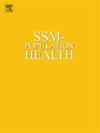Trajectories and patterns of US counties’ policy responses to the COVID-19 pandemic: A sequence analysis approach
IF 3.6
2区 医学
Q1 PUBLIC, ENVIRONMENTAL & OCCUPATIONAL HEALTH
引用次数: 0
Abstract
Background
It is increasingly recognized that policies played a role in mitigating or exacerbating health inequities during the COVID-19 pandemic. While US counties were particularly active in policymaking, limited work has characterized geographic and temporal variation in pandemic-era policymaking at the local level, a prerequisite for later studies examining the health effects of these policies. This paper fills this gap by characterizing county-level COVID-19-related policy trajectories over time using a novel national policy database and innovative methods.
Methods
Data came from the US COVID-19 County Policy (UCCP) Database, including 309 counties in 50 states plus Washington DC during January 2020 to December 2021. We examined measures of overall policy comprehensiveness, as well as three domains including containment and closure, economic response, and public health. We applied sequence analysis to characterize county-level trajectories overall and within each policy domain, and cluster analysis to group similar trajectories.
Results
There was wide variation in policymaking, with nearly half of counties demonstrating consistently comprehensive policymaking, about 15–20% with consistently low comprehensiveness, and the remainder exhibiting intermittent comprehensiveness. Economic policies were less comprehensive than containment/closure and public health policies. There was also substantial variation within and across states, and associations with county characteristics.
Conclusion
This study is among the first to document substantial geographic and temporal variation in a variety of US county-level COVID-19-related policies, which likely contributed to health disparities during and after the pandemic. Future work should evaluate how these different policy trajectories differentially affected health and social outcomes.
美国各州应对COVID-19大流行政策的轨迹和模式:序列分析方法
背景:人们越来越认识到,在2019冠状病毒病大流行期间,政策在减轻或加剧卫生不平等方面发挥了作用。虽然美国各县在决策方面特别积极,但有限的工作体现了大流行时期地方一级决策的地理和时间差异,这是后来研究这些政策对健康影响的先决条件。本文利用一个新的国家政策数据库和创新方法,描绘了一段时间以来县级与covid -19相关的政策轨迹,填补了这一空白。方法:数据来自美国COVID-19县政策(UCCP)数据库,包括2020年1月至2021年12月期间50个州的309个县和华盛顿特区。我们研究了总体政策全面性的措施,以及三个领域,包括遏制和关闭、经济应对和公共卫生。我们应用序列分析来描述县级总体和每个政策领域内的轨迹,并使用聚类分析来对相似的轨迹进行分组。结果:政策制定的差异很大,近一半的县表现出一贯的综合政策,约15-20%的县表现出一贯的低综合政策,其余县表现出间歇性的综合政策。经济政策不如遏制/关闭和公共卫生政策全面。在州内和州间也有很大的差异,并与县的特征有关。结论:这项研究是第一批记录美国各种县级covid -19相关政策的重大地理和时间差异的研究之一,这可能导致了大流行期间和之后的健康差异。今后的工作应评估这些不同的政策轨迹如何以不同的方式影响健康和社会结果。
本文章由计算机程序翻译,如有差异,请以英文原文为准。
求助全文
约1分钟内获得全文
求助全文
来源期刊

Ssm-Population Health
PUBLIC, ENVIRONMENTAL & OCCUPATIONAL HEALTH-
CiteScore
6.50
自引率
2.10%
发文量
298
审稿时长
101 days
期刊介绍:
SSM - Population Health. The new online only, open access, peer reviewed journal in all areas relating Social Science research to population health. SSM - Population Health shares the same Editors-in Chief and general approach to manuscripts as its sister journal, Social Science & Medicine. The journal takes a broad approach to the field especially welcoming interdisciplinary papers from across the Social Sciences and allied areas. SSM - Population Health offers an alternative outlet for work which might not be considered, or is classed as ''out of scope'' elsewhere, and prioritizes fast peer review and publication to the benefit of authors and readers. The journal welcomes all types of paper from traditional primary research articles, replication studies, short communications, methodological studies, instrument validation, opinion pieces, literature reviews, etc. SSM - Population Health also offers the opportunity to publish special issues or sections to reflect current interest and research in topical or developing areas. The journal fully supports authors wanting to present their research in an innovative fashion though the use of multimedia formats.
 求助内容:
求助内容: 应助结果提醒方式:
应助结果提醒方式:


